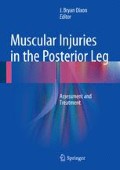Abstract
The pathophysiology of muscle injury is a complex process, which is not yet fully understood. There is a variety of risk factors, which influence the location, severity, and resulting limitations that injuries cause. The pathophysiology is unique to each of the three most common primary injuries contusions, lacerations, and strains. The structural makeup of the musculoskeletal system also has a large influence in the biomechanics of our movement, and thus on the locations of injuries and the requirements of healing.
Our knowledge of the pathophysiology of muscle injury is rapidly expanding. Muscle injury follows the well-described process seen in healing of many different types of tissue—inflammation, repair, and remodeling. The more we learn about the inflammation phase, the more it becomes clear that this phase sets the stage for the repair and remodeling to follow. Our understanding of satellite cells, myogenic regulatory factors (MRFs), and many of the other unique cellular pathways required to help heal muscles is still evolving. Once injuries have been stabilized, remodeling of the injury plays an important role in returning to full function. To fully maximize return to function, there must be a coordinated effort to limiting the damage caused by inflammation, minimize scar formation, and maximize the remodeling phase with well-established rehab protocols.
Access this chapter
Tax calculation will be finalised at checkout
Purchases are for personal use only
References
Whiting WC, Zernicke RF. Biomechanics of musculoskeletal injury. 2nd ed. Chelsea: Sheridan Books; 2008.
Järvinen TA, Järvinen TL, Kääriäinen M, Kalima H, Järvinen M. Muscle injuries biology and treatment. Am J Sports Med. 2005;33:745–64.
Page P. Pathophysiology of acute exercise-induced muscular injury: clinical implications. J Athl Train. 1995;30(1):29–34.
DeLee JC, Drez D Jr, Miller MD. DeLee & Drez’s orthopaedic sports medicine principles and practice. 3rd ed. Philadelphia: Saunders; 2010.
Lewis PB, Ruby D, Bush-Joseph CA. Muscle soreness and delayed-onset muscle soreness. Clin Sports Med. 2012;31(2):255–62.
Magee DJ, Manske RC, Zachazewski JE, Quillen WS. Athletic and sport issues in musculoskeletal rehabilitation. St Louis: Elsevier; 2011.
Abraham WM. Factors in delayed muscle soreness. Med Sci Sports. 1977;9(1):11–20.
Stauber WT, Willems ME. Prevention of histopathologic changes from 30 repeated stretches of active rat skeletal muscles by long inter-stretch rest times. Eur J Appl Physiol. 2002;88(1–2):94–9.
Wiesel BB, Sankar WN, Delahay JN, Wiesel SW. Orthopaedic surgery principles of diagnosis and treatment. Philadelphia: Lippincott Williams and Wilkins; 2011.
Robbins SL, Kumar V, Cotran RS. Robbins and Cotran pathologic basis of disease. 8th ed. Philadelphia: Saunders; 2010.
Singer AJ, Thode HC Jr, Hollander JE. National trends in ED lacerations between 1992 and 2002. Am J Emerg Med. 2006;24(2):183–8.
Quinn JV, Polevoi SK, Kohn MA. Traumatic lacerations: what are the risks for infection and has the ‘golden period’ of laceration care disappeared? Emerg Med J. 2014;31(2):96–100.
Beiner JM, Jokl P. Muscle contusion injuries: current treatment options. J Am Acad Orthop Surg. 2001;9(4):227–37.
Tidball JG, Salem G, Zernicke R. Site and mechanical conditions for failure of skeletal muscle in experimental strain injuries. J Appl Physiol. 1993;74(3):1280–6.
Garrett WE Jr, Safran MR, Seaber AV, Glisson RR, Ribbeck BM. Biomechanical comparison of stimulated and nonstimulated skeletal muscle pulled to failure. Am J Sports Med. 1987;15(5):448–54.
Hurme T, Kalimo H, Lehto M, Järvinen M. Healing of skeletal muscle injury: an ultrastructural and immunohistochemical study. Med Sci Sports Exerc. 1991;23(7):801–10.
Pinniger GJ, Lavin T, Bakker A. Skeletal muscle weakness caused by carrageenan-induced inflamation. Muscle Nerve. 2012;46:413–20.
Supinski GS, Callahan LA. Free radical-mediated skeletal muscle dysfunction in inflammatory conditions. J Appl Physiol. 2007;102:2056–63.
Zanou N, Gailly P. Skeletal muscle hypertrophy and regeneration: interplay between the myogenic regulatory factors (MRFs) and insulin-like growth factors (IGFs) pathways. Cell Mol Life Sci. 2013;70:4117–30. Epub ahead of print accessed at pubmed.gov.
Ghaly A, Marsh D. Ischaemia-reperfusion modulates inflammation and fibrosis of skeletal muscle after contusion injury. Int J Exp Path. 2010;91:244–55.
Singh K, Dilworth JF. Differential modulation of cell cycle progression distinguishes members of the myogenic regulatory factor family of transcription factors. FEBS J. 2013;280:3991–4003. Epub ahead of print accessed at pubmed.gov.
Author information
Authors and Affiliations
Corresponding author
Editor information
Editors and Affiliations
Rights and permissions
Copyright information
© 2016 Springer Science+Business Media New York
About this chapter
Cite this chapter
Swentik, A. (2016). Pathophysiology of Skeletal Muscle Injury. In: Dixon, J. (eds) Muscular Injuries in the Posterior Leg. Springer, Boston, MA. https://doi.org/10.1007/978-1-4899-7651-2_4
Download citation
DOI: https://doi.org/10.1007/978-1-4899-7651-2_4
Published:
Publisher Name: Springer, Boston, MA
Print ISBN: 978-1-4899-7649-9
Online ISBN: 978-1-4899-7651-2
eBook Packages: MedicineMedicine (R0)

